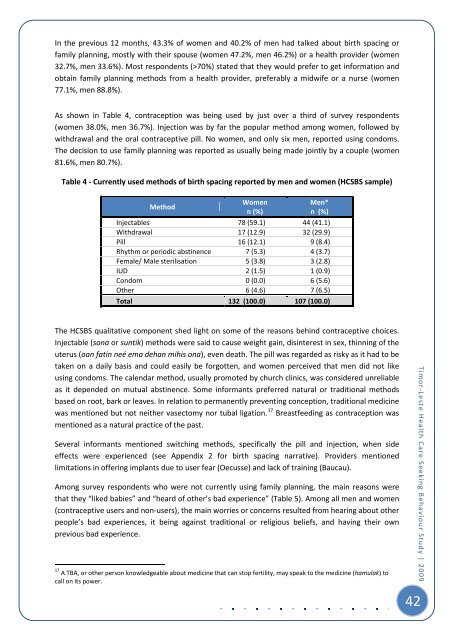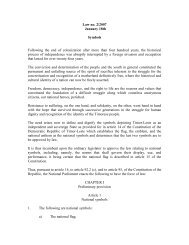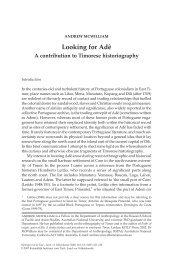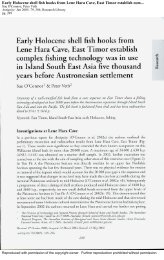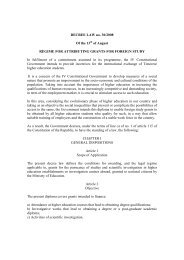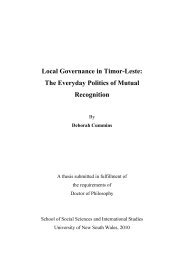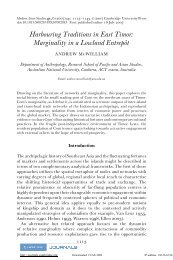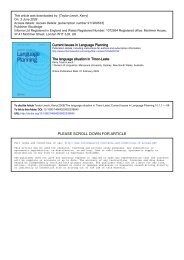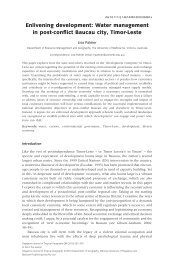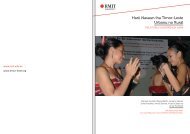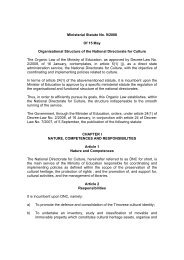Timor-Leste Health Care Seeking Behaviour Study - Secretaria de ...
Timor-Leste Health Care Seeking Behaviour Study - Secretaria de ...
Timor-Leste Health Care Seeking Behaviour Study - Secretaria de ...
- No tags were found...
Create successful ePaper yourself
Turn your PDF publications into a flip-book with our unique Google optimized e-Paper software.
In the previous 12 months, 43.3% of women and 40.2% of men had talked about birth spacing orfamily planning, mostly with their spouse (women 47.2%, men 46.2%) or a health provi<strong>de</strong>r (women32.7%, men 33.6%). Most respon<strong>de</strong>nts (>70%) stated that they would prefer to get information andobtain family planning methods from a health provi<strong>de</strong>r, preferably a midwife or a nurse (women77.1%, men 88.8%).As shown in Table 4, contraception was being used by just over a third of survey respon<strong>de</strong>nts(women 38.0%, men 36.7%). Injection was by far the popular method among women, followed bywithdrawal and the oral contraceptive pill. No women, and only six men, reported using condoms.The <strong>de</strong>cision to use family planning was reported as usually being ma<strong>de</strong> jointly by a couple (women81.6%, men 80.7%).Table 4 - Currently used methods of birth spacing reported by men and women (HCSBS sample)MethodWomenn (%)Men*n (%)Injectables 78 (59.1) 44 (41.1)Withdrawal 17 (12.9) 32 (29.9)Pill 16 (12.1) 9 (8.4)Rhythm or periodic abstinence 7 (5.3) 4 (3.7)Female/ Male sterilisation 5 (3.8) 3 (2.8)IUD 2 (1.5) 1 (0.9)Condom 0 (0.0) 6 (5.6)Other 6 (4.6) 7 (6.5)Total 132 (100.0) 107 (100.0)The HCSBS qualitative component shed light on some of the reasons behind contraceptive choices.Injectable (sona or suntik) methods were said to cause weight gain, disinterest in sex, thinning of theuterus (oan fatin neé ema <strong>de</strong>han mihis ona), even <strong>de</strong>ath. The pill was regar<strong>de</strong>d as risky as it had to betaken on a daily basis and could easily be forgotten, and women perceived that men did not likeusing condoms. The calendar method, usually promoted by church clinics, was consi<strong>de</strong>red unreliableas it <strong>de</strong>pen<strong>de</strong>d on mutual abstinence. Some informants preferred natural or traditional methodsbased on root, bark or leaves. In relation to permanently preventing conception, traditional medicinewas mentioned but not neither vasectomy nor tubal ligation. 17 Breastfeeding as contraception wasmentioned as a natural practice of the past.Several informants mentioned switching methods, specifically the pill and injection, when si<strong>de</strong>effects were experienced (see Appendix 2 for birth spacing narrative). Provi<strong>de</strong>rs mentionedlimitations in offering implants due to user fear (Oecusse) and lack of training (Baucau).Among survey respon<strong>de</strong>nts who were not currently using family planning, the main reasons werethat they “liked babies” and “heard of other’s bad experience” (Table 5). Among all men and women(contraceptive users and non-users), the main worries or concerns resulted from hearing about otherpeople’s bad experiences, it being against traditional or religious beliefs, and having their ownprevious bad experience.17 A TBA, or other person knowledgeable about medicine that can stop fertility, may speak to the medicine (hamulak) tocall on its power.42<strong>Timor</strong>-<strong>Leste</strong> <strong>Health</strong> <strong>Care</strong> <strong>Seeking</strong> <strong>Behaviour</strong> <strong>Study</strong> | 2009


